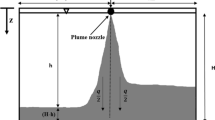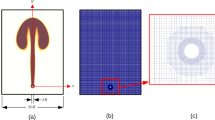Abstract
Buoyant turbulent plumes are often categorized by their geometry and described as either round plumes, issuing from a point source, or line/planar plumes, issuing from an elongated source. As line plumes rise above their source they get thicker (normal to the source axis) and, far from the source, they will no longer be planar but more resemble a round plume. However, the vast majority of experimental measurements of line plumes focus on the near source region, where they are still planar and the flow is two-dimensional. Further, these experiments constrain the ends of the plume with barriers to prevent entrainment through the ends of the plume and maintain a two-dimensional flow. Herein, results are presented from a series of experiments that were conducted to measure the transition of an unconstrained line plume into a round plume. A model is presented that allows the calculation of the entrainment into a plume of arbitrary cross sectional shape in terms of the hydraulic radius of the plume defined as the cross-sectional area divided by the perimeter over which entrainment is occurring. This formulation, along with a smooth transition function that changes both the geometry and entrainment coefficient, is used to make predictions of the front position over time for a line plume in a filling box. The model was run for different values of the nozzle width to box height ratio. Results of the model were compared to the experimental front position measurements and show that an unconstrained line plume will transition to a round plume at a height equal to approximately three times the source width. This is consistent with the idea that the line plume will transition when its thickness is similar in magnitude to its nozzle width.


















Similar content being viewed by others
Abbreviations
- \(\alpha \) :
-
Entrainment coefficient (-)
- \(\alpha _L\) :
-
Entrainment coefficient for a line plume (-)
- \(\alpha _{L.G}\) :
-
Entrainment coefficient for a line plume with Gaussian velocity profile (-)
- \(\alpha _R \) :
-
Entrainment coefficient for a round plume (-)
- \(\varDelta \rho \) :
-
Density difference between the plume and ambient fluid (\(kg/m^3\))
- \(\eta \) :
-
Non-dimensional first front height (-)
- \(\varGamma_{T} \) :
-
Flux balance parameter at the transition height (-)
- \(\lambda \) :
-
Non-dimensional plume transition height (-)
- \(\phi \) :
-
Non-dimensional transition distance (-)
- \(\psi \) :
-
Ratio of the round plume to line plume filling box time (-)
- \(\rho \) :
-
Plume fluid density (\(kg/m^3\))
- \(\rho _0 \) :
-
Ambient density (\(kg/m^3\))
- \(\tau \) :
-
Non-dimensional time (-)
- \(\forall \) :
-
Tank volume (\(m^3\))
- \(\zeta _T \) :
-
Plume transition height scaled on the tank height (-)
- b:
-
Plume radius or half width (m)
- f:
-
Buoyancy flux per unit width (\(m^3/s^3\))
- g:
-
Gravitational acceleration (\(m/s^2\))
- g’:
-
Reduced gravity \(m/s^2\))
- h:
-
Height of the first front (m)
- m:
-
Momentum flux per unit width (\(m^3/s^2\))
- q:
-
Flow rate per unit width (\(m^2/s\))
- u:
-
Top hat vertical velocity (m/s)
- z:
-
Vertical coordinate measured from the plume source (m)
- \(z^*\) :
-
Non-dimensional height (-)
- \(z_T\) :
-
Plume transition height (m)
- \(z_v\) :
-
Virtual origin height (m)
- A:
-
Plume cross sectional area (\(m^2\))
- \(A_T\) :
-
Tank cross sectional area (\(m^2\))
- \(C_L\) :
-
Line plume flow rate coefficient (-)
- \(C_R\) :
-
Round plume flow rate coefficient (-)
- F:
-
Buoyancy flux (\(M^4/s^3\))
- \(F_B\) :
-
Buoyancy force (N)
- H:
-
Tank height (m)
- M:
-
Momentum flux (\(m^4/s^3\))
- P:
-
Entraining perimeter (m)
- Q:
-
Volume flux (\(m^3/s\))
- \(Q^*\) :
-
Non-dimensional volume flux (-)
- R:
-
Hydraulic Radius (m)
- \(R_T\) :
-
Equivalent radius of tank (m)
- \(R_L\) :
-
Line plume hydraulic radius (m)
- \(R_R\) :
-
Round plume hydraulic radius (m)
- S.G.:
-
Plume fluid specific gravity (-)
- \(T_{fill}\) :
-
Filling box time for a line plume (s)
- W:
-
Line plume source width (m)
References
Akhter R, Kaye NB (2020) Experimental investigation of a line plume in a filling box. Environ Fluid Mech. https://doi.org/10.1007/s10652-020-09754-6
Albini FA (1996) Iterative solution of the radiation transport equations governing spread of fire in wildland fuel. Fizika Goreniya i Vzryva 32(5):71–82
Allgayer D, Hunt GR (2012) On the application of the light-attenuation technique as a tool for non-intrusive buoyancy measurements. Exp Therm Fluid Sci 38:257–261
Baines WD (1983) A technique for the direct measurement of volume flux of a plume. J Fluid Mech 132:247–256
Baines WD, Turner JS (1969) Turbulent buoyant convection from a source in a confined region. J Fluid Mech 37:51–80
Bejan A, Ziaei S, Lorente S (2014) Evolution: why all plumes and jets evolve to round cross sections. Sci Rep. https://doi.org/10.1038/srep04730
Bush JWM, Woods AW (1999) Vortex generation by line plumes in a rotating stratified fluid. J Fluid Mech 388:289–313
Ching CY, Fernando HJS, Robles A (1995) Breakdown of line plumes in turbulent environments. J Geophys Res 100(C3):4707. https://doi.org/10.1029/94jc02701
Ching CY, Fernando HJS, Mofor LA, Davies PA (1996) Interaction between multiple line plumes: a model study with applications to leads. J Phys Ocean 26:525–540
Fernando HJS, Ching CY (1993) Effects of background rotation on turbulent line plumes. J Phys Oceanograph 23(9):2125–2129. https://doi.org/10.1175/1520-0485(1993)023<2125:eobrot>2.0.co;2
Hu L, Liu S, Zhang X (2017) Flame heights of line-source buoyant turbulent non-premixed jets withair entrainment constraint by two parallel side walls. Fuel 200:583–589
Hunt GR, Kaye NB (2005) Lazy plumes. J Fluid Mech 533:329–338
Huppert HE, Sparks RSJ, Whitehead JA, Hallworth MA (1986) Replenishment of magma chambers by light inputs. J Geophys Res 91:6113–6122
Jackson RH, Shroyer EL, Nash JD, Sutherland DA, Carroll D, Fried MJ, Catania GA, Bartholomaus TC, Stearns LA (2017) Near-glacier surveying of a subglacial discharge plume: Implications for plume parameterizations. Geophys Res Lett 44(13):6886–6894. https://doi.org/10.1002/2017gl073602
Kaye NB, Hunt GR (2007) Overturning in a filling box. J Fluid Mech 576:297–323
Kaye NB, Linden PF (2004) Coalescing axisymmetric turbulent plumes. J Fluid Mech 502:41–63
Kotsovinos NE (1977) Plane turbulent buoyant jets. part 2. Turbulence structure. J Fluid Mech 81:45–62
Kotsovinos NE, List EJ (1977) Plane turbulent buoyant jets. part 1. Integral properties. J Fluid Mech 81:25–44
Lee JHW, Chu VH (2003) Turbulent jets and plumes a Lagrangian approach. Kluwer Academic Publishers, Netherlands
Lee SL, Emmons HW (1961) A study of natural convection above a line fire. J Fluid Mech 11(03):353. https://doi.org/10.1017/s0022112061000573
Li S, Flynn MR (2020a) Merging of long rows of plumes: crosswinds, multiple rows, and applications to cooling towers. Phys Rev Fluids 5(9):094,502, https://doi.org/10.1103/physrevfluids.5.094502
Li S, Flynn MR (2020) Merging of two plumes from area sources with applications to cooling towers. Phys Rev Fluids 5(054):502. https://doi.org/10.1103/PhysRevFluids.5.054502
Linden PF, Lane-Serff GF, Smeed DA (1990) Emptying filling boxes, the fluid mechanics of natural ventilation. J Fluid Mech 212:309–335
Ma Y, Flynn MR, Sutherland BR (2017) Convection from a line-source into a two-layer stratified ambient fluid. J Fluid Mech 818:46–67. https://doi.org/10.1017/jfm.2017.143
Morton BR, Middleton J (1973) Scale diagrams for forced plumes. J Fluid Mech 58:165–176
Morton BR, Taylor GI, Turner JS (1956) Turbulent gravitational convection from maintained and instantaneous sources. Proc Roy Soc Lond A 234:1–23
Paillat S, Kaminski E (2014) Entrainment in plane turbulent pure plumes. J Fluid Mech. https://doi.org/10.1017/jfm.2014.424
Parker DA, Burridge HC, Partridge JL, Linden PF (2019) A comparison of entrainment in turbulent line plumes adjacent to and distant from a vertical wall. J Fluid Mech. https://doi.org/10.1017/jfm.2019.790
Ramaprian BR, Chandrasekhara MS (1989) Measurements in vertical plane turbulent plumes. J Fluids Eng 111(1):69–77. https://doi.org/10.1115/1.3243602
Roberts PJW (1979) Line plume and ocean outfall dispersion. J Hydraul Division 105(4):313–331. https://doi.org/10.1061/jyceaj.0005175
Rooney GG (2015) Merging of a row of plumes or jets with an application to plume rise in a channel. J Fluid Mech 771
Rooney GG (2016) Merging of two or more plumes arranged around a circle. J Fluid Mech 796:712–731
Thomas P (1987) On the upward movement of smoke and related shopping mall problems. Fire Saf J 12(3):191–203. https://doi.org/10.1016/0379-7112(87)90005-1
Thomas P, Morgan H, Marshall N (1998) The spill plume in smoke control design. Fire Saf J 30(1):21–46. https://doi.org/10.1016/s0379-7112(97)00037-4
Acknowledgements
The authors would like to thank Dr. Abdul Khan for the use of the visualization tank for the experiments and Scott Black for assistance in the design and construction of the line plume nozzle. This material is based upon work supported by the National Science Foundation under Grant No.1703548. Any opinions, findings, and conclusions or recommendations expressed in the material are those of the author and do not necessarily reflect the views of the NSF.
Author information
Authors and Affiliations
Corresponding author
Additional information
Publisher's Note
Springer Nature remains neutral with regard to jurisdictional claims in published maps and institutional affiliations.
Rights and permissions
About this article
Cite this article
Kaye, N.B., Robinson, D.M., Akhter, R. et al. The transition of a line plume to round plume. Environ Fluid Mech 22, 763–787 (2022). https://doi.org/10.1007/s10652-022-09852-7
Received:
Accepted:
Published:
Issue Date:
DOI: https://doi.org/10.1007/s10652-022-09852-7




